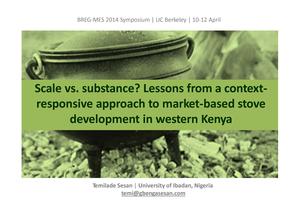Slow and Steady But Not to Scale: Lessons from a Context-responsive Approach to Market-based Stove Development in Western Kenya
From energypedia
Revision as of 18:18, 8 May 2014 by ***** (***** | *****)
Slow and Steady But Not to Scale: Lessons from a Context-responsive Approach to Market-based Stove Development in Western Kenya
Presenter: Temilade Sesan, (University of Ibadan, Nigeria)
Rapporteur: Max Morrison
Overview
| Improved stoves targeted at the 2.6 billion people worldwide that use solid biomass for cooking have not been taken up in the numbers expected by donors and practitioners. Following widespread critique of the subsidy-based dissemination models popular in the 1970s and 1980s, donors have begun to emphasise the potential of market-based models to increase stove adoption rates. In analysing the USEPA project implemented by Practical Action in western Kenya, this paper examines how a market-based approach has translated in the kind of informal economy operated by many biomassreliant communities. The paper concludes that a context-responsive approach is likely to facilitate the dissemination of locally appropriate interventions, but it may not always be compatible with mainstream visions of large-scale stove deployment.[1] |  |
Issues Presented
► Please see the presentation.
- Issues revolving around scaling-up of cookstove market.
- Who is using stoves, how are these people and others benefited?
- Solid fuels -> More health risks
- Info source: Interviews w/ ~15 people in Kenya.
- Urban/ Rural areas use different proportions of charcoal fuel. (higher proportion in urban)
- Stove use concentrated where fuel used is less polluting. (urban)
- Subsidies for stoves not effective at ensuring stove use.
- This hampers scale up/ financial stability and therefore implementation of a market ideology.
- Bottom of pyramid users have most need, least financial ability.
- “Economy of Affection” People do not necessarily make “rational” decisions. Family tradition has an impact on land value for example.
- The goal is to make the market sustainable after the organization leaves. -> 100 stoves at a time allows for larger loans, and therefore less cost per user and more marketability.
- These stoves had a more effective penetration of the very low income – high need populations
- Qualitative vs Quantitative -> high impact, low scale
- Stoves designed for 5 years. This longevity was an issue to achieve in practice, as well as stove repurchase after failure.
- There is a greater issue in getting people in rural areas to use the stoves rather than getting a sufficient amount of stoves produced/distributed.
Q & A
1. Is entrepeneurship a large barrier to adoption?
- A: More entrepreneurship in urban areas. Some women’s groups supply these stoves to more rural areas. There needs to be support for those who are less able to organize themselves and acquire these stoves. Stove markets have developed since the 70’s and some are self-sustaining at this point.
2. What differentiates Kenya in terms of stove penetration?
- Energy poverty has created a large demand for biomass fuel in cities, and so stoves are sought after in urban areas.
3. What is your experience w/ microfinance institutions?
- Community savings results on loans from working together to buy a larger number of stoves. Issues regarding getting people to actually use the loaned money for stoves. People sometimes wanted to use the loans for other entrepreneurial endeavors.
- Free fuel is an issue for rural adoption. One benefit of the stove is increased efficiency, but free fuel doesn’t factor into these areas. The benefits to these people are limited to health from reduced smoke exposure.
- Possibility of educating women in tech/entrep. So that they can help spread stove knowledge/implementation.
4. Is there a role the state could play in encouraging stove use? Does marketing affect urban demand?
- There have been efforts to educate people on benefit of reduced smoke exposure. The issue with free fuel comes up again as efficiency is not a selling point for these people. Health benefits nebulous and as such less of a driving factor. Re: state assistance approach. Chinese: central planning increased adoption. India: Subsidies allowed initial adoption, people did not buy a second after the first one broke. Varying levels of success w/ state assistance approach. More states tend toward LPG encouragements rather than biomass stoves. Most subsarahan states do not prioritize biomass stoves.
5. If you were the state, what would you do?
- In Nigeria, there is much more encouragement of petroleum liquid fuel. These seem to be more effective, far reaching than biomass fuel.
References
- ↑ Slow and Steady But Not to Scale: Lessons from a Context-responsive Approach to Market-based Stove Development in Western Kenya. Temilade Sesan.




















